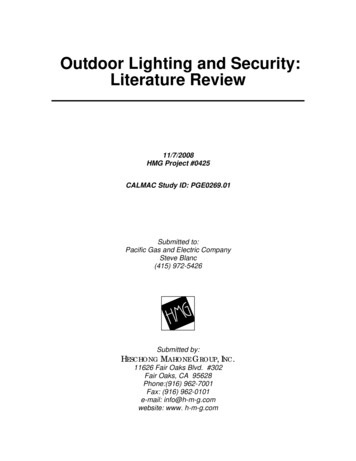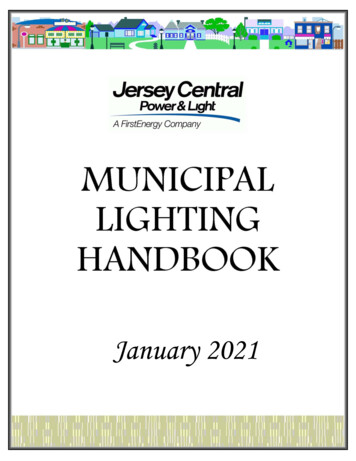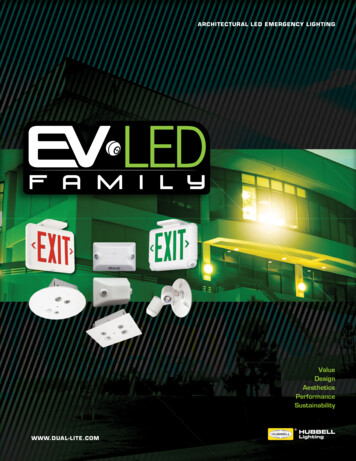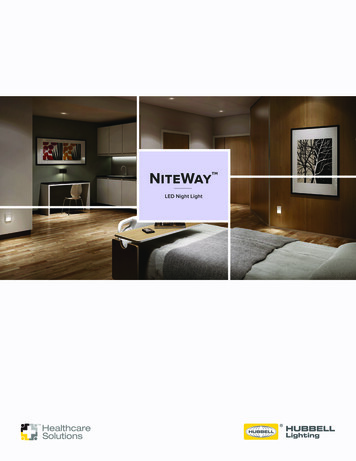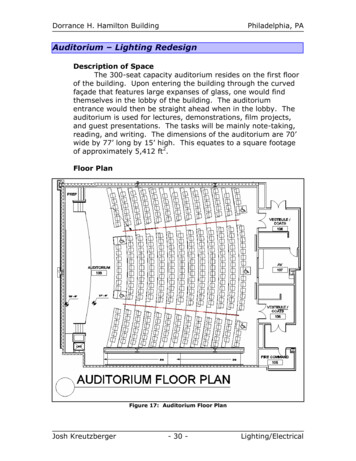
Transcription
Dorrance H. Hamilton BuildingPhiladelphia, PAAuditorium – Lighting RedesignDescription of SpaceThe 300-seat capacity auditorium resides on the first floorof the building. Upon entering the building through the curvedfaçade that features large expanses of glass, one would findthemselves in the lobby of the building. The auditoriumentrance would then be straight ahead when in the lobby. Theauditorium is used for lectures, demonstrations, film projects,and guest presentations. The tasks will be mainly note-taking,reading, and writing. The dimensions of the auditorium are 70’wide by 77’ long by 15’ high. This equates to a square footageof approximately 5,412 ft2.Floor PlanFigure 17: Auditorium Floor PlanJosh Kreutzberger- 30 -Lighting/Electrical
Dorrance H. Hamilton BuildingPhiladelphia, PADesign ConceptThe design concept of the auditorium is to provide variousscenes for the different tasks of the space, provide ample tasklighting on the desks, and to accent the chalkboard/whiteboard.The space should provide a user friendly control system with thescene selection at the touch of a button. A smooth transitionfrom the lobby will be incorporated into the design.Design CriteriaAppearance of Space and LuminairesThe appearance of the space and luminaires issomewhat important in the auditorium. The auditoriumwill hold seminars with special speakers; therefore, thespace and luminaires need to be aesthetically pleasing.Color Appearance (and Color Contrast)Color appearance can affect visibility and aesthetics.A color rendering index (CRI) of 70 or above is acceptablewhen dealing with educational facilities; however, a CRIgreater than 80 may be needed in order to ensure apleasant appearance of skin tones. Since the auditoriumwill have special speakers and guest lecturers, a CRI of 80or greater will be beneficial. A CCT should be around 3500K in order to provide a warmer feel to the space.Light Distribution on SurfacesHarsh striated patterns of excessive brightness ornoticeable shadows should be avoided. Illuminancepatterns should correspond with objects of the space.Ceiling and walls should have luminances within a 3:1ratio. The current layout should not provide a harshpattern on any surfaces in the space. The walls of thespace can be uniform or non-uniform depending on thefinal design. Acoustical panels are on the upper portion ofthe wall. Depending on the appearance of the panels, adecision will be made on whether or not to make the lighton the walls uniform or non-uniform.Light Distribution on Task Plane (Uniformity)Patterns of light on the task plane should be uniform.The desks in the room are used for reading and writing. Anon-uniform pattern of light on the work plane would bedistracting or confusing. The task illuminance should behigher than the immediate surroundings. With a workJosh Kreutzberger- 31 -Lighting/Electrical
Dorrance H. Hamilton BuildingPhiladelphia, PAplane illuminance that is 1.5 to 3 times higher than thosein the surrounding areas will assist in directing theoccupants’ attention to the task, which is very important ineducational facilities. The illuminance of the speakershould also be illuminated greater than the surroundingtasks (approximately 25-30 fc).Point(s) of InterestThe points of interest in the space include theprojection screen and the podium at the front of the space.The projection screen should be a lower illuminance andthe podium will prosper with a slightly higher illuminance.Source/Task/Eye GeometryExtremely important to a lecture hall is thesource/task/eye geometry. The angular relationshipsbetween the viewer, the task, and the luminaire arefrequently critical to task visibility. This should not be anissue due to the height of the ceiling.System Control and FlexibilitySystem control and flexibility is very important dueto the different tasks in the space. A couple of differentsystems include a scene for a projection screen, a guestspeaker, lectures, and general reading/writing tasks.Dimming ballasts will be required.Illuminance (Horizontal)The IESNA handbook calls for a horizontalilluminance of 50 lux (5 fc) on the work plane forauditoriums; however, the horizontal illuminance of aclassroom is 500 lux (50 fc). When the projection screenis in use, a horizontal illuminance of 50 lux (5 fc) on thework plane is needed.Illuminance (Vertical)The IESNA handbook recommends a verticalilluminance of 30 lux (3 fc) when the projection screen isin use. The points of interest for vertical illuminanceinclude the chalkboard, the speaker, and the projectionscreen. Note that the projection screen should be a lowerilluminance than the surrounding space.Josh Kreutzberger- 32 -Lighting/Electrical
Dorrance H. Hamilton BuildingPhiladelphia, PAPower Allowances from ASHRAE 90.1 StandardsThe power allowance by the space by space methodfor a classroom, lecture, or training space is 1.4 W/ft2.ReflectancesCeiling: Sloped Gypsum Wallboard Planes with Fascias toFollow Radius of Seating Tiers Assume 90% ceiling reflectanceWalls: Fabric Covered Acoustical Panels/WoodPanels/Painted Gypsum Wallboard Assume 50% wall reflectanceFloor: Constantine Commercial Carpet, “CorporateExchange” 12’ W Broadloom; Color T.B.D. Assume 20% floor reflectanceFixture talogue No.16’1 – T5HOREZ-154 – Mark10 PowerlineElectronicDimming/Programmed W-2CWQ27716’2 – 32 WattCFLIZT-2T42-M3BS@277 – Mark 7– ElectronicDimming/Programmed Start64277EdisonPriceLightingTRPH W-277GLRLabelDescriptionMHF-C1Concealed Cove-30System with HighReflectance WhiteReflectorsF-C2Triples-H 232/7Recessed CFLDownlight/Wallwasher with EvenToneClear ReflectorF-C3Strip LED Lights forthe Stairs4”10 – LEDSPackaged UnitF-C4Obround WallMount Luminairewith SpecularAluminum Reflector11’2 – F40T8B-D2 – AdvanceElectronic/InstantStart OptaniumTable 11: Auditorium Fixture ScheduleJosh Kreutzberger- 33 -Lighting/Electrical
Dorrance H. Hamilton BuildingPhiladelphia, PALight Loss FactorsThe assumed room cleaning period for this room is 6months and the room is clean. The expected dirt depreciationwas calculated at 8%.RCR [(5)*(H)*(L W)] / (L)*(W)RCR [(5)*(15’)*(77’ 70’)] / (5412 ft2) 2.04 e 12: Auditorium Light Loss FactorsBallast geMax THD%Mfr.Catalogue No.B-C1ElectronicDimming/Programmed Start631.0012010Advance – Mark10 PowerlineREZ-154B-C2Mark 7 –ElectronicDimming/Programmed onic/Instant Start/2Lamp811.0327710Advance –OptaniumVOP-4P32-SCTable 13: Auditorium Ballast InformationJosh Kreutzberger- 34 -Lighting/Electrical
Dorrance H. Hamilton BuildingPhiladelphia, PALamp 30HO ALTO TGL-C2PL-T32W/830GX24Q-3/4P823000322400L-C4F40T8 r.BallastPhilipsREZ-154 – Mark 10Powerline ElectronicDimming/Programmed Start2000PhilipsIZT-2T42-M3BS@277 – Mark 7 –ElectronicDimming/Programmed Start3500PhilipsB-D2 – AdvanceElectronic/InstantStart Optanium4500Table 14: Auditorium Lamp InformationPower DensityLabelBallast WattsNo. of FixturesTotal 77965Watt Total5412Square Foot Total1.47 W/ft2Table 15: Auditorium Power DensityTherefore, the power density is slightly above the targetIESNA value of 1.4 W/ft2. If the power density must be lowerthan 1.4 W/ft2, then the amount of cove luminaires could bereduced in order to obtain the proper power density. The spaceis at an appropriate illuminance level of approximately 42.3 fc,so the power density is sufficient.Josh Kreutzberger- 35 -Lighting/Electrical
Dorrance H. Hamilton BuildingPhiladelphia, PALighting PlanFigure 18: Auditorium Lighting PlanLighting ControlsThe different zones represent different dimming areas. ALutron 100 system is being utilized by the DH Hamilton Building.Occupancy sensors are being used as in the previous spaces.Josh Kreutzberger- 36 -Lighting/Electrical
Dorrance H. Hamilton BuildingPhiladelphia, PARenderingsFigure 19: Rendering of AuditoriumFigure 20: Rendering of AuditoriumJosh Kreutzberger- 37 -Lighting/Electrical
Dorrance H. Hamilton BuildingPhiladelphia, PARenderingsFigure 21: Rendering of AuditoriumFigure 22: Rendering of AuditoriumJosh Kreutzberger- 38 -Lighting/Electrical
Dorrance H. Hamilton BuildingPhiladelphia, PAPseudo ColorFigure 23: Pseudo Color of AuditoriumFigure 24: Pseudo Color of AuditoriumJosh Kreutzberger- 39 -Lighting/Electrical
Dorrance H. Hamilton BuildingPhiladelphia, PAConclusionThe auditorium was the hardest space to provide thelighting design for. The space had a curved ceiling with variousheights across the whole ceiling. A curved cove was usedthroughout the space to achieve some area lighting. The rest ofthe ambient lighting was done through downlights. The stepshave a built in LED strip. Overall, the lighting design achievedthe space design goals. The average illuminance on the workplane was 42.3 fc, which is low for the IESNA value for aclassroom/lecture space of 50 fc. The power density was 1.47W/ft2, which was slightly over the ASHRAE 90.1 Standards of 1.4W/ft2 for a classroom/lecture space.Josh Kreutzberger- 40 -Lighting/Electrical
Josh Kreutzberger - 40 - Lighting/Electrical Conclusion The auditorium was the hardest space to provide the lighting design for. The space had a curved ceiling with various heights across the whole ceiling. A curved cove was used throughout the space to achieve some area lighting. The rest of the ambie





